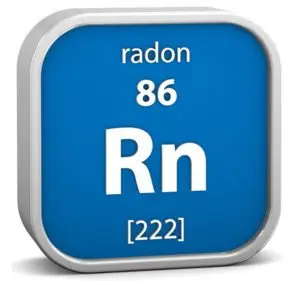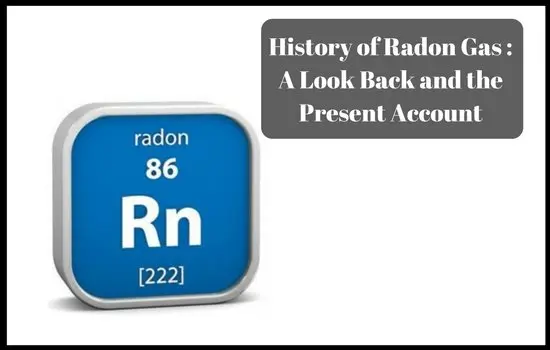Table of Contents
History of Radon Gas: A Look Back And The Present Account
Radon isn’t a commercially produced gas just for the purpose of benefiting from it. The gas is formed due to certain natural processes i.e. with the breakdown (decay) of uranium under the soil. The element radon was first discovered by Fredrich E. Dorn, a German physicist in the year 1990. While he was working with the element radium (studying radium’s decay chain), he named it radium emanation. After uranium, radium, thorium, and polonium, Radon was the fifth radioactive element that was discovered at that time.

Today, we know radon is a radioactive gas that’s odorless, colorless, and tasteless. It is a naturally occurring result of decaying uranium which is actually the heaviest element on earth. Radon has an atomic number 86 with the chemical symbol Rn. Gas is considered to be a critical health hazard that keeps affected human health throughout time.
Several times, reports from the United States Environmental Protection Agency (US EPA) have stated how radon causes damage that is almost next to the loss caused due to cigarette smoking. It actually leads to more than 21,000 deaths every year and increasing cases of problems related to lung cancer. This gas is the 6th leading cause of lung cancer-related deaths around the globe.
Acceptable Radon Levels
As per the standards, a construction that has radon levels under the measures of 4 pCi/L is considered to be safe. While any building that has a level that is more than 4 pCi/L is said to be exposed to radiation that is 35 times as harmful as standing next to a radioactive waste site. However, this is also true that essentially no levels of radon can be called safe, but 4 pCi/L is somewhat an acceptable measure. And almost $2 billion dollars annually are invested in radon-related healthcare costs (directly or indirectly) in the United States. Nearly 1 in every 3 homes according to the EPA reports has radon levels above 4pCi/L, therefore, remediation plans have also been suggested.
Radon gets formulated due to decaying uranium that’s been present in the surroundings since the earth formed. This means the existence has been like uranium, radium, and thus radon which will fundamentally remain to subsist forever and probably at the same levels as of now (or maybe more).
History of Radon Gas

Friedrich Ernst Dorn discovered radon in the year 1900 when he noticed that radium compounds were actually originating some radioactive emissions during an experiment that he was carrying out. He named this emission Radium Emanation (Ra Em). It is however said that in the year 1899, Pierre and Marie Curie had already observed such an emission that remained radioactive but only for around a month.
Similar Radiations.
The same year, Owens and Ernest Rutherford along with Robert B noticed continuous emissions from thorium oxide that remained radioactive for a couple of minutes. This radiation was called an emanation (emanate in Latin meaning expiration or to elapse). Later, it was officially named Thorium Emanation (Th Em). Rutherford in the year 1901 had demonstrated the radioactivity of emanations however credited Curies for the element’s discovery. André-Louis Debierne noticed similar radiations from actinium naming it Actinium Emanation (Ac Em).
All three discoveries got recognized by several suggested names like extortion, exradio, and exacting in the year 1904; thoron, radon, and action in the year 1918 along with thereon, Radeon, and action in the year 1919. But, it was only in the 1920s that the names radon, thoron, and actinon were finalized.
However, in the year 1910, Sir William Ramsay and Robert Whytlaw-Gray were the ones to isolate radon and also determined its density suggesting that the radiation might contain some elements from the category of noble gases. A fresh name got suggested for the emanation as Niton (Nt) because the gas caused an unusual glow when came in contact with some particular substances. In the year 1912, the International Commission for Atomic Weights accepted this name. However, in the year 1913, the International Union of Pure and Applied Chemistry (IUPAC) along with The International Committee for Chemical Elements acted upon and finalized the names radon (Rn), thoron (Tn), and action (An). After all of this, radon and radon fluoride obtained their first synthesized compound in the year 1962.
Initial Study
The dangers associated with high radon exposure have been long known. However, the first major study of radon dangerously affecting human, as well as animal health, was determined in the context of uranium mining. The affected areas were found to be Joachimsthal in Bohemia and Southwest regions of the United States. And the issue got highlighted during the days when the cold war was happening. The problem was said to be a miner’s disease and a ventilation system was advised to be installed in the mines. It was also called a mountain sickness which later on was identified as a condition leading to severe lung cancer. And since then the neglected gas has been taking away lives for which mitigation systems have been asked to tighten up.
Radon Facts
Upon cooling and getting to a solid state, the gas glows in yellow color. And as the temperature lowers, the gas shines in an orange-red color. Radon has a half-life which is about 3.8 days and has a stable isotope (radon-222). Basically, radon seeps into constructions as the result of underground decaying uranium, radium, or thorium ores. Plus it also varies greatly in amounts from region to region.
It is highly dangerous, however; on the other hand, very small amounts of radon are also used in treating certain types of cancer by established and certified hospitals. Otherwise, radon must not prevail inside our houses or business constructions. If any amount above the level of 4pCi/L exists in the building, the detector must ensure the accurate number, and accordingly, the required ventilation systems must be made use of!